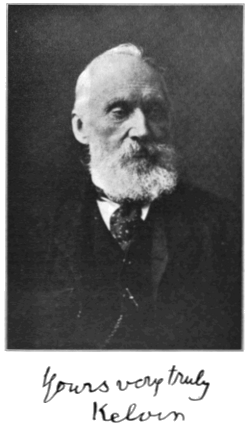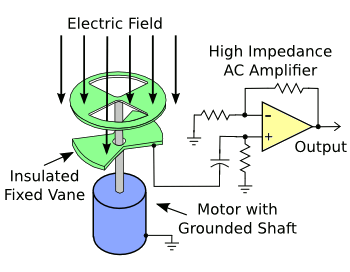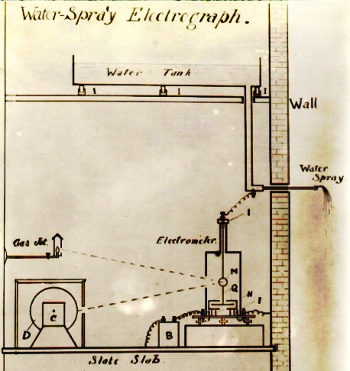Kelvin and Atmospheric Electricity
June 19, 2013
William Thomson (1824-1907), also known as Lord Kelvin, was a
British physicist. Kelvin is best known for determining that -273.15
Celsius is the value of
absolute zero on the
temperature scale. For this work, we've named the temperature unit, the
kelvin, in his honor.

Like most physicists, Kelvin's interests went beyond a single topic area. Kelvin's analysis of the fundamental problem of the
age of the Earth was interesting as being correct, given all the facts known at the time, but incorrect in the end. Kelvin calculated the likely lifetime of the
Sun, based just on its generating
heat by
gravitational collapse, only, and he got a number too small to allow
Darwinian evolution.
(Wikimedia Commons image.
Kelvin also calculated the time it would have taken for the
Earth's crust to have cooled from the
temperature of its
core, and he got 20-40 million years. He had much greater success when he moved into
applied studies, especially on the topic of the first
transatlantic telegraph cable.
Experiments by foremost
electrician,
Michael Faraday, showed that the
data rate of such cables diminished with length. The cause of this was the distributed
capacitance of the cable, where the cable conductor and the sea water act as
plates of a capacitor for which the cable cladding was the
dielectric. Kelvin rightly saw that a reduction in cable resistance by using a larger diameter conductor, and a reduction in the capacitance by using thicker
insulation, would improve the
data rate,
The modern solution to this problem, before the invention of
electronic amplifiers, is the dispersal of
loading coils along the length of the cable. These are
inductors that balance the cable capacitance. In the cable's original state, the only solution was a very sensitive detector, the
mirror galvanometer. Even with that, the data rate was excruciatingly slow.
A recent
arXiv paper by
Karen Aplin of the
Physics Department,
Oxford University, and
Giles Harrison of the
Department of Meteorology,
University of Reading, recalls another of Kelvin's scientific interests; namely,
atmospheric electricity.[1] The
electrical potential increases with
altitude above Earth's surface by a surprisingly high value, 100
volts per
meter (30 volts per
foot), increasing with the approach of
thunderstorms.
So, why aren't we all walking around in a frenzied and perpetual
bad hair day? The voltages may be high, but the
currents, which are carried by a few
ionized molecules in the
air, are very small. We can only see such potential differences if we have a really
high impedance voltmeter, or an
electrometer.[2]
One of the most common such field measuring devices is the
field mill, which combines an
electrostatic shutter and an
alternating current amplifier, as shown in the figure. Since alternating currents are easier to amplify than
direct currents, a
motor periodically
shields the sensing
electrode from the Earth's field. Not surprisingly, a
MEMS field mill was demonstrated more than a
decade ago.[3]

Schematic diagram of a simple field mill.
If the motor shaft is not grounded, as would be the case when it spins on a nylon bearing, a conducting brush is needed to ground the shaft.
(Illustration by the author, using Inkscape.)
Kelvin, who became interested in atmospheric electricity in 1859, did not have the advantage of modern
electronics for his studies. The first practical amplifier,
Lee de Forest's Audion, wasn't invented until 1906. As one who commonly jumped from one
physics area to another, Kelvin discontinued his atmospheric electrical studies just two years later, in 1861.[1]
Although the existence of an atmospheric potential, even in fair weather, was know for many decades before Kelvin's time, he was the first to offer
quantitative data.[1] Kelvin invented a novel
water spray
electrometer for measuring the atmospheric
potential gradient; and, for his time, the extremely novel use of
photography as a means for
data logging.
Rather than measuring the potential of the air, directly, Kelvin's water spray electrometer measured the potential of an
insulated tank spraying water into the air. The potential of the tank equilibrates to that of the air at the altitude where the water spray become
droplets that are no longer electrically connected to the tank. The water tank equilibrates to this potential because of
charge transfer by the water drops.[1]
The equilibration occurs since any potential difference between the tank and the air will transfer charge to, or from, the water tank, which acts as a capacitor. You can calculate all this from the list of capacitor equations in a
previous article (Carbon Nano-Onion Supercaps, August 26, 2010).
Kelvin's water spray electrometer, as illustrated in his
notebook schematic, below, included photographic recording of the data from the mirror electrometer, and a
battery reference. In the figure, B = battery, C = driving
clock for the data recorder, D = a cylinder coated with a
photosensitive medium, M = electrometer mirror (illuminated by a
gas light), and I =
Insulators.

Kelvin's water spray electrograph.
A portion of Fig. 2 of Ref. 1, modified for contrast, via (arXiv.)[1)]
As a true
scientist, Kelvin realized that his photographic data wiggles needed a reference, so he used
zinc-copper cells, which generate 1.08 volts. In one measurement, Kelvin related the atmospheric potential to the equivalent of a series connection of 115 of these cells, or 124.2 volts. For his vertical distance from the ground of three feet, this gives a voltage gradient of 137 volts/meter.[1] Kelvin thought that such potential measurements would help in
weather forecasting.[1] Indeed, field mills are now used to give warning of impending thunderstorms.
In some of his measurements, Kelvin may have detected changes in the atmospheric potential gradient from the
Carrington Event, a
solar storm that continued from August 28, 1859, until September 2, 1859.[1] This caused the largest recorded
geomagnetic storm ever recorded, with
auroral lights of extreme intensity. The electrical disturbance from this geomagnetic storm caused problems for the primitive
telegraph circuits of the time, and a similar event would likely disrupt modern
civilization for many months.
References:
- K. L. Aplin and R. G. Harrison, "Lord Kelvin's atmospheric electricity measurements," arXiv Preprint Server, May 23, 2013.
- Chapter 6, "Instrumentation And Measurements," from Lars Wåhlin, "Atmospheric Electricity," Research Studies Press, John Wiley & Sons (New York, 1989), ISBN 0-471-91202-6.
- Mark N. Horenstein and Patrick R. Stone, "A micro-aperture electrostatic field mill based on MEMS technology," Journal of Electrostatics, vols. 51–52 (May 2001), pp. 515-521.
Permanent Link to this article
Linked Keywords: William Thomson (1824-1907); First Baron Kelvin; British; physicist; Celsius; absolute zero; temperature scale; kelvin; age of the Earth; Sun; heat; gravitational collapse; Darwinian evolution; Earth; crust; temperature; core; applied physics; transatlantic telegraph cable; classical electromagnetism; electrician; Michael Faraday; submarine communications cable; bandwidth problem; data rate; capacitance; capacitor plate; dielectric; electronic amplifier; loading coil; inductor; mirror galvanometer; data rate; arXiv; Karen Aplin; Physics Department; Oxford University; Giles Harrison; Department of Meteorology; University of Reading; atmospheric electricity; electrical potential; altitude; volt; meter; foot; thunderstorm; bad hair day; current; ionized; molecule; atmosphere of Earth; air; high impedance; voltmeter; electrometer; field mill; electrostatic; alternating current; amplifier; direct current; electric motor; Faraday cage; shield; electrode; microelectromechanical system; MEMS; decade; electrical ground; nylon; bearing; conducting brush; Inkscape; electronics; Lee de Forest; Audion; physics; quantitative data; water; electrometer; potential gradient; photography; data logger; data logging; insulated; tank; droplet; charge; lab notebook; battery; clock; photosensitive; gas light; insulator; arXiv; scientist; voltaic pile; zinc-copper cell; weather forecasting; solar storm of 1859; Carrington Event; geomagnetic storm; Aurora; auroral lights; electrical telegraph; telegraph circuit; civilization.